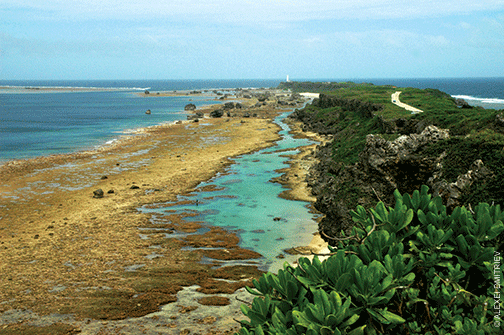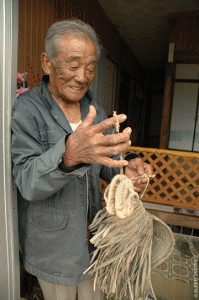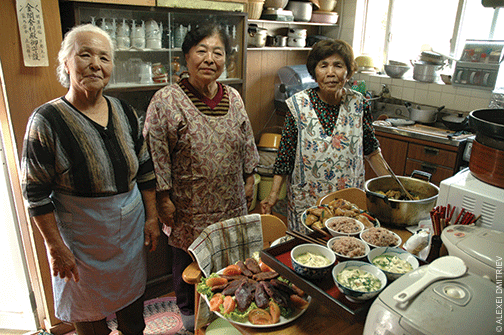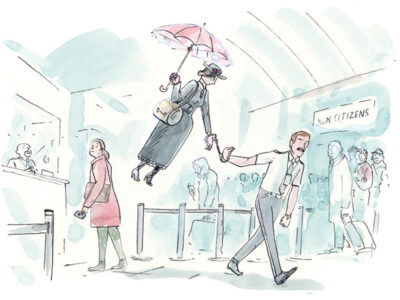
Looking for the secrets of longevity in the Okinawan archipelago.
By Alexei Dmitriev | I am kneeling on Hoshizuna beach among Japanese tourists crawling on all fours. On the tropical island of Iriomote in the Okinawa archipelago, three hours south of Tokyo by air, we are searching for “star sand”—tiny marine protozoa exoskeletons. Okinawans traditionally believe they are the babies of the Southern Cross and North Star, killed by a giant serpent. My fellow gatherers appear quite engaged; they have to gather enough “stars” to duly bestow upon their friends and colleagues back in mainland Japan. I show them an easier way, pressing my palm into the sand to see if any “stars” stick to it. The Japanese nod—“hai, hai”—and happily emulate my method. They seem out of their element. For them, Okinawa is a type of exotic Shangri-La, like Hawaii for Oklahomans.
It is certainly not the Japan we have come to know. Rush-hour throngs, bullet trains, and the neon lights of pachinko parlors are nowhere to be seen. At twilight, the forest on neighboring Ishigaki Island is lit up by a myriad of fast-flickering green Yaeyama fireflies. Back on mangrove-strangled Iriomote, mainland Japan is a distant memory. The island’s 3,000 native residents seem more concerned over the future of the near-extinct yamaneko wild cat than with the effects of the Fukushima nuclear disaster. Life proceeds as slowly as the water buffalo carts that in low tide ply the isthmus between Iriomote and Yubu Island. Their phlegmatic drivers let the cattle tread through the water at their own pace, and focus on extracting a meditative tune from their sanshins, three-stringed instruments covered in snake skin.
People here are Okinawans first and Japanese citizens second. Before these islands were annexed by Japan in 1879, they had comprised the Chinese-influenced Ryukyu kingdom for 500 years. While mainland Japan shunned the rest of the world, the Ryukyu kings prospered by trading with all of Southeast Asia. They held a magnificent court in the Shuri castle, situated on a hill overlooking Naha, the capital of the prefecture. Its replica still stands bright red and impressive—albeit fully reconstructed after the original, like pretty much everything else on Okinawa island, was wiped out in 1945 during the “typhoon of steel”—as the three-month-long Battle for Okinawa is referred to here. After the war, Okinawa remained under the control of the US Military Occupation Government until it was returned to Japan in 1972. Today, with less than 1 percent of the country’s landmass, Okinawa accommodates three-quarters of the US military presence in Japan.
In the coastal Peace Prayer Park, I zigzag between rows of black granite slabs bearing the names of 100,000 Okinawans, 107,000 Japanese, and 12,000 Americans who perished in the battle. Monuments commemorating the fallen from each prefecture in Japan look down from a wooded hill onto school kids who stencil the names of relatives on sheets of paper to take home. If one may celebrate the aesthetics of mourning, then these memorials exemplify superb taste and refinement. Above them all, on top of the seaside cliff known as Hill 89, stands a stele to mark the site where on June 22, 1945, Japanese General Mitsuru Ushijima committed ritual suicide when all was lost. In accordance with the Imperial Army etiquette governing seppuku, his aide then beheaded the disemboweled general to minimize his suffering.
Cigarettes, coins, and origami are left by the stele. After everything it had to endure in World War II Japan is a great supporter of peace, but it cherishes the memory of its heroes.
Later in the day, the same school kids crowd a viewing platform overlooking Kadena Air Force base, watching in awe the take-offs and landings of US military jets there to protect their country. Aware of the funds the Japanese national government disburses to Okinawa for hosting the US military, the locals for the most part do not seem bothered by the American presence. The peculiar cultural integration is exemplified by the most popular dish on the island, which combines a very healthful (and equally bitter) local vegetable called goya with canned Spam. Every morning, farmers whose ancestral lands happen to be inside the perimeter stream into the base to tend their crops while F-22 Raptors fly overhead.
Okinawa has an exotic, tropical flavor that sets it apart from mainland Japan. Yonaguni, the southernmost island in the Okinawa archipelago, lies only 60 miles from Taiwan, versus 1,250 from Tokyo. Okinawans make sugar from sugarcane, farm pineapples and mangoes, and infuse awamori, a potent local hooch made of Thai rice, with the bodies of venomous pit vipers.
“In Okinawa things always run slow,” I heard an Osaka manager complain when the check-in line at Ishigaki airport was moving at a more leisurely pace than the clockwork precision he was used to. Yet it was hard not to appreciate the upside of “Okinawa time.” It’s OK to be late for a meeting, but it was also OK for my cab driver on Miyako Island to call the port master and ask him to hold the boat to tiny Ogami when we were stuck behind a crawling thresher on a narrow road. And the boat did wait!

I wondered if this relaxed lifestyle could have something to do with Okinawans’ longevity; the archipelago is famous for being home to the largest proportion of centenarians in the world. And not only do they live long lives, Okinawans also enjoy more years free from medical problems.
“We are non-assuming, quiet, and optimistic people that are often being taken advantage of, but we do not see a need to change,” an old fisherman on Ogami told me. That pinprick island’s population of 17 souls is elderly. There is no medical facility, but the locals do not want to move—a large part of Ogami is considered sacred and is off limits to everyone except a handful of alternating priestesses.
For a more scientific view on what makes Okinawans live longer, I paid a visit to Dr. Makoto Suzuki, who for the last 30 years has been running the Okinawa Research Center for Longevity Studies, documenting the lives of some 700 elderly Okinawans. His research forms the basis of The Okinawa Program, a bestselling book he co-authored with Canadians Craig and Bradley Willcox. Suzuki believes that the secret of long life has little to do with hereditary factors, and rests instead on four pillars of health: diet, an active lifestyle, self-reliance, and spirituality.
Okinawans traditionally consume a large amount of soy along with vegetables like goya, purple potato, daikon, and turmeric, and less meat and dairy products, although they have a soft spot for pork. They are much less fond of fish than in mainland Japan, but love seaweed—including slimy mozuku and so-called “green caviar,” or sea grapes. In addition to papaya, which is eaten unripe, the other local favorite is shikuwasa, a sour citrus fruitrich in nobiletin, a chemical believed to inhibit cancer-cell growth. Okinawans also eat in moderation. There is even a saying—hara hachi bu—that means “eight-tenths full.” According to Suzuki, practicing hara hachi bu helps to prevent obesity by keeping the stomach from stretching, which otherwise would increase the amount of food needed to feel full.
Most of the elderly in Suzuki’s studies are used to working the land and continue gardening into very advanced age. Regular exercise, which in extreme cases includes marathon running and underwater spearfishing, keeps their bodies strong and supple. I saw village men playing gateball, a type of croquet, with dexterity far surpassing their age.

On Okinawa Island I was invited to lunch with three widowed cousins—85, 86, and 90 years old—who between them had 27 children and over 90 grandchildren. “There was no electricity in the village when we were young, so once it got dark we would go to bed,” one of them said with a coy smile. The next day I returned to visit them at a weekly gathering that functioned like a combination of a medical check-up, dancing party, and gossip exchange among the 30 or so women in attendance. The two oldest were graceful dancers at 98, and told me that when they have a break from gardening and housework they do calligraphy and pottery.
“Old age allows one to try many interesting things,” one of them remarked.
As I was leaving the village I saw a hearse driving in. When it is finally time for Okinawans to die they are buried, then exhumed a couple years later. The bones are washed with awamori and placed in huge family sarcophagi that reminded me of gigantic turtle shells. Okinawans see those sarcophagi as a symbolic womb to which people return after death, and which continue to play a part in the spiritual support of the living. And indeed they serve as hubs of social life for their occupants’ descendants. Families gather by them with food and awamori, adults sing, kids play, and everybody has a good time.
“Our ancestor worship is devoid of sadness,” my guide told me. “It is important for the young to know where they come from. The ancestors teach us to be responsible members of the society and family.”
And there they lodged in my memory as I departed, subtleties lost in translation: turtle shells versus eternal wombs, marine exoskeletons versus stellar descendents. It was hard not to think that the world could learn a thing or two from Okinawans, who have persevered through many a typhoon, and not by diet alone.
Alexei Dmitriev G’88 is a documentary filmmaker in Potomac, Maryland.




